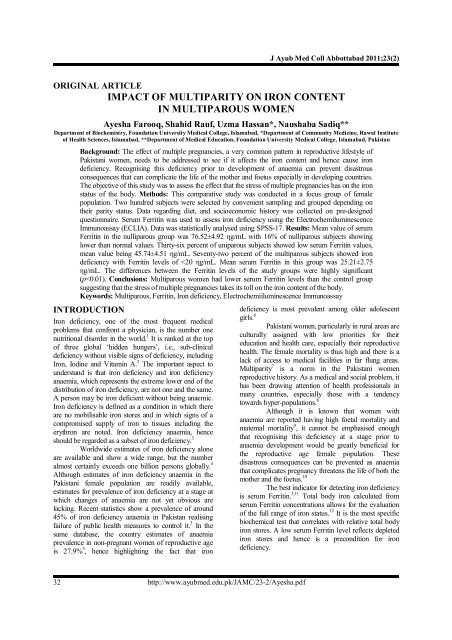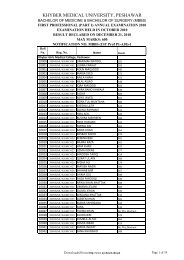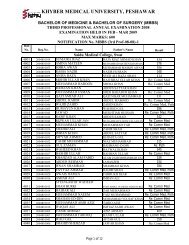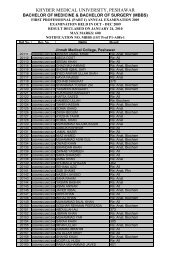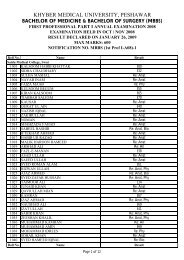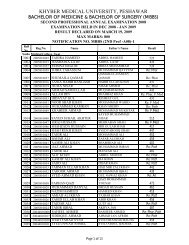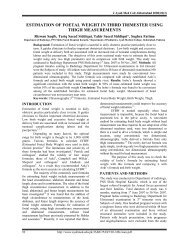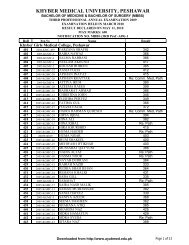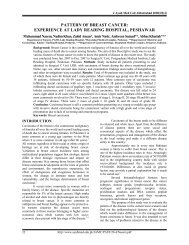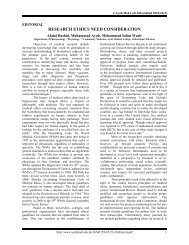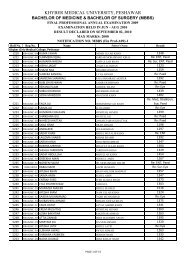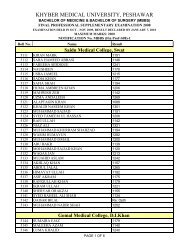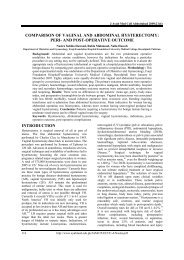impact of multiparity on iron content in multiparous women
impact of multiparity on iron content in multiparous women
impact of multiparity on iron content in multiparous women
Create successful ePaper yourself
Turn your PDF publications into a flip-book with our unique Google optimized e-Paper software.
J Ayub Med Coll Abbottabad 2011;23(2)<br />
ORIGINAL ARTICLE<br />
IMPACT OF MULTIPARITY ON IRON CONTENT<br />
IN MULTIPAROUS WOMEN<br />
Ayesha Farooq, Shahid Rauf, Uzma Hassan*, Naushaba Sadiq**<br />
Department <str<strong>on</strong>g>of</str<strong>on</strong>g> Biochemistry, Foundati<strong>on</strong> University Medical College, Islamabad, *Department <str<strong>on</strong>g>of</str<strong>on</strong>g> Community Medic<strong>in</strong>e, Rawal Institute<br />
<str<strong>on</strong>g>of</str<strong>on</strong>g> Health Sciences, Islamabad, **Department <str<strong>on</strong>g>of</str<strong>on</strong>g> Medical Educati<strong>on</strong>, Foundati<strong>on</strong> University Medical College, Islamabad, Pakistan<br />
Background: The effect <str<strong>on</strong>g>of</str<strong>on</strong>g> multiple pregnancies, a very comm<strong>on</strong> pattern <strong>in</strong> reproductive lifestyle <str<strong>on</strong>g>of</str<strong>on</strong>g><br />
Pakistani <strong>women</strong>, needs to be addressed to see if it affects the ir<strong>on</strong> c<strong>on</strong>tent and hence cause ir<strong>on</strong><br />
deficiency. Recognis<strong>in</strong>g this deficiency prior to development <str<strong>on</strong>g>of</str<strong>on</strong>g> anaemia can prevent disastrous<br />
c<strong>on</strong>sequences that can complicate the life <str<strong>on</strong>g>of</str<strong>on</strong>g> the mother and foetus especially <strong>in</strong> develop<strong>in</strong>g countries.<br />
The objective <str<strong>on</strong>g>of</str<strong>on</strong>g> this study was to assess the effect that the stress <str<strong>on</strong>g>of</str<strong>on</strong>g> multiple pregnancies has <strong>on</strong> the ir<strong>on</strong><br />
status <str<strong>on</strong>g>of</str<strong>on</strong>g> the body. Methods: This comparative study was c<strong>on</strong>ducted <strong>in</strong> a focus group <str<strong>on</strong>g>of</str<strong>on</strong>g> female<br />
populati<strong>on</strong>. Two hundred subjects were selected by c<strong>on</strong>venient sampl<strong>in</strong>g and grouped depend<strong>in</strong>g <strong>on</strong><br />
their parity status. Data regard<strong>in</strong>g diet, and socioec<strong>on</strong>omic history was collected <strong>on</strong> pre-designed<br />
questi<strong>on</strong>naire. Serum Ferrit<strong>in</strong> was used to assess ir<strong>on</strong> deficiency us<strong>in</strong>g the Electrochemilum<strong>in</strong>escence<br />
Immunoassay (ECLIA). Data was statistically analysed us<strong>in</strong>g SPSS-17. Results: Mean value <str<strong>on</strong>g>of</str<strong>on</strong>g> serum<br />
Ferrit<strong>in</strong> <strong>in</strong> the nulliparous group was 76.52±4.92 ηg/mL with 16% <str<strong>on</strong>g>of</str<strong>on</strong>g> nulliparous subjects show<strong>in</strong>g<br />
lower than normal values. Thirty-six percent <str<strong>on</strong>g>of</str<strong>on</strong>g> uniparous subjects showed low serum Ferrit<strong>in</strong> values,<br />
mean value be<strong>in</strong>g 45.74±4.51 ηg/mL. Seventy-two percent <str<strong>on</strong>g>of</str<strong>on</strong>g> the <strong>multiparous</strong> subjects showed ir<strong>on</strong><br />
deficiency with Ferrit<strong>in</strong> levels <str<strong>on</strong>g>of</str<strong>on</strong>g>
J Ayub Med Coll Abbottabad 2011;23(2)<br />
The reference ranges for Ferrit<strong>in</strong> are 30–<br />
400 ηg/mL for males, and 13–150 ηg/mL for<br />
females. 13,14 Cl<strong>in</strong>ically, a threshold value <str<strong>on</strong>g>of</str<strong>on</strong>g> 20 ηg/mL<br />
has proved useful <strong>in</strong> the diagnosis <str<strong>on</strong>g>of</str<strong>on</strong>g> ir<strong>on</strong> deficiency. 15<br />
Ir<strong>on</strong> deficiency with anaemia is seen when a pers<strong>on</strong> has<br />
low values <str<strong>on</strong>g>of</str<strong>on</strong>g> both serum Ferrit<strong>in</strong> and haemoglob<strong>in</strong>. 16<br />
This study was designed to see the Ir<strong>on</strong><br />
c<strong>on</strong>tent <str<strong>on</strong>g>of</str<strong>on</strong>g> blood <strong>in</strong> <strong>multiparous</strong> <strong>women</strong> and compare it<br />
with the same <strong>in</strong> nulliparous and uniparous <strong>women</strong>. 17,18<br />
MATERIAL AND METHODS<br />
This comparative study was c<strong>on</strong>ducted at Fauji<br />
Foundati<strong>on</strong> Hospital, Rawalp<strong>in</strong>di from April 2010 to<br />
April 2011. Selecti<strong>on</strong> <str<strong>on</strong>g>of</str<strong>on</strong>g> 200 female subjects who met<br />
the specified criteria, between the age group <str<strong>on</strong>g>of</str<strong>on</strong>g> 20–40<br />
years was d<strong>on</strong>e through c<strong>on</strong>venient sampl<strong>in</strong>g. They<br />
were divided <strong>in</strong>to groups <strong>on</strong> the basis <str<strong>on</strong>g>of</str<strong>on</strong>g> their parity.<br />
These <strong>women</strong> bel<strong>on</strong>ged to middle socioec<strong>on</strong>omic class<br />
(average m<strong>on</strong>thly <strong>in</strong>come <str<strong>on</strong>g>of</str<strong>on</strong>g> PKR 20,000–25,000). Age,<br />
socioec<strong>on</strong>omic status and dietary variables were kept <strong>in</strong><br />
a c<strong>on</strong>stant range so as to least affect the results. Pregnant<br />
<strong>women</strong>, lactat<strong>in</strong>g mothers, <strong>women</strong> show<strong>in</strong>g detectable<br />
causes <str<strong>on</strong>g>of</str<strong>on</strong>g> ir<strong>on</strong> deficiency <strong>on</strong> history and cl<strong>in</strong>ical<br />
exam<strong>in</strong>ati<strong>on</strong>, and <strong>women</strong> tak<strong>in</strong>g ir<strong>on</strong> supplements were<br />
excluded from the study. C<strong>on</strong>sent <str<strong>on</strong>g>of</str<strong>on</strong>g> the patient to<br />
participate <strong>in</strong> this study was taken.<br />
Demographic and medical history was taken.<br />
Dietary history through Food Frequency questi<strong>on</strong>naire 19<br />
with stress <strong>on</strong> frequency <str<strong>on</strong>g>of</str<strong>on</strong>g> <strong>in</strong>take <str<strong>on</strong>g>of</str<strong>on</strong>g> ir<strong>on</strong> rich foods was<br />
taken. Cl<strong>in</strong>ical exam<strong>in</strong>ati<strong>on</strong> was performed <strong>on</strong> all<br />
subjects and f<strong>in</strong>d<strong>in</strong>gs were entered <strong>in</strong> a Performa. Five<br />
to ten ml. venous blood was collected from the selected<br />
subjects and centrifuged for 1–2 m<strong>in</strong>utes. Serum was<br />
transferred to another tube and used for assessment <str<strong>on</strong>g>of</str<strong>on</strong>g><br />
Ferrit<strong>in</strong> by Electro-chemi-lum<strong>in</strong>escence Immunoassay<br />
(ECLIA) Serum Ferrit<strong>in</strong> assay us<strong>in</strong>g COBAS E. 13 A<br />
two step ‘sandwich’ immunometric technique was<br />
performed. Results were determ<strong>in</strong>ed by the calibrati<strong>on</strong><br />
curve generated by the mach<strong>in</strong>e.<br />
Data was analysed us<strong>in</strong>g ANOVA <strong>on</strong> SPSS-<br />
17. Quantitative variables were described as Mean±SD<br />
and 95% c<strong>on</strong>fidence <strong>in</strong>terval. Categorical variable were<br />
expressed as frequencies or percentages. Post Hoc<br />
Tukey’s Test was applied to see multiple comparis<strong>on</strong><br />
between <strong>in</strong>dividual groups and p
J Ayub Med Coll Abbottabad 2011;23(2)<br />
haemorrhage dur<strong>in</strong>g delivery. In the absence <str<strong>on</strong>g>of</str<strong>on</strong>g><br />
supplemented ir<strong>on</strong>, however, the mother’s stores will be<br />
depleted and will not be able to meet the needs <str<strong>on</strong>g>of</str<strong>on</strong>g> the<br />
foetus. 24 In the <strong>multiparous</strong> group 64% had normal<br />
serum Ferrit<strong>in</strong>, the average value be<strong>in</strong>g 45.74 ηg/mL.<br />
Eighteen (36%) subjects showed Ferrit<strong>in</strong> c<strong>on</strong>centrati<strong>on</strong>s<br />
<strong>in</strong> the range <str<strong>on</strong>g>of</str<strong>on</strong>g> ir<strong>on</strong> deficiency. Hence the effects <str<strong>on</strong>g>of</str<strong>on</strong>g> ir<strong>on</strong><br />
deficiency are evident <strong>in</strong> this group as dur<strong>in</strong>g<br />
pregnancy, <strong>women</strong> have an <strong>in</strong>creased demand for ir<strong>on</strong><br />
<strong>in</strong> order to expand their erythrocyte mass and fulfil the<br />
ir<strong>on</strong> needs <str<strong>on</strong>g>of</str<strong>on</strong>g> the grow<strong>in</strong>g foetus. 25,26 In the <strong>multiparous</strong><br />
group <strong>on</strong>ly 28% had normal serum Ferrit<strong>in</strong> levels, and<br />
mean serum Ferrit<strong>in</strong> c<strong>on</strong>centrati<strong>on</strong> <strong>in</strong> this group was<br />
25.21 ηg/mL. Seventy-two percent <str<strong>on</strong>g>of</str<strong>on</strong>g> the <strong>multiparous</strong><br />
<strong>women</strong> showed Ferrit<strong>in</strong> levels <strong>in</strong> the range <str<strong>on</strong>g>of</str<strong>on</strong>g>
J Ayub Med Coll Abbottabad 2011;23(2)<br />
24. L<strong>on</strong>go D, Fauci A, Kasper D, Hauser S, James<strong>on</strong> J, Loscalzo J.<br />
Harris<strong>on</strong>’s pr<strong>in</strong>ciples and practice <str<strong>on</strong>g>of</str<strong>on</strong>g> <strong>in</strong>ternal medic<strong>in</strong>e. 18 th<br />
Editi<strong>on</strong>. New York: McGraw-Hill Pr<str<strong>on</strong>g>of</str<strong>on</strong>g>essi<strong>on</strong>al; 2011.<br />
25. Hallberg L. Ir<strong>on</strong> balance <strong>in</strong> pregnancy. Vitam<strong>in</strong>s and M<strong>in</strong>erals <strong>in</strong><br />
Pregnancy and Lactati<strong>on</strong>. Nestles Nutr Workshop Series<br />
1988;16:115–27.<br />
26. Milman N, Bergholt T, Byg KE, Eriksen L, Graudal N. Ir<strong>on</strong> status<br />
and ir<strong>on</strong> balance dur<strong>in</strong>g pregnancy. A critical reappraisal <str<strong>on</strong>g>of</str<strong>on</strong>g> ir<strong>on</strong><br />
supplementati<strong>on</strong>. Acta Obstet Gynecol Scand 1999;78:749–57.<br />
27. An<strong>on</strong>ymous. Anemia dur<strong>in</strong>g pregnancy a major public health<br />
problem. Safe Mother 1993;11:1–2.<br />
28. US Preventive Services Task Force. Rout<strong>in</strong>e ir<strong>on</strong><br />
supplementati<strong>on</strong> dur<strong>in</strong>g pregnancy. Policy statement. Review<br />
article. JAMA 1993;270:2846–54.<br />
29. Report <str<strong>on</strong>g>of</str<strong>on</strong>g> a Jo<strong>in</strong>t FAO/WHO Expert C<strong>on</strong>sultati<strong>on</strong>. Requirements<br />
<str<strong>on</strong>g>of</str<strong>on</strong>g> Vitam<strong>in</strong> A, ir<strong>on</strong>, folate and Vitam<strong>in</strong> B 12. FAO Food Nutr Pap<br />
1988;23:33–50.<br />
Address for Corresp<strong>on</strong>dence:<br />
Dr. Ayesha Farooq, Assistant Pr<str<strong>on</strong>g>of</str<strong>on</strong>g>essor Biochemistry, Foundati<strong>on</strong> University Medical College, Islamabad, Pakistan.<br />
Cell: +92-333-5174423<br />
Email: ayeshafarooque@gmail.com<br />
http://www.ayubmed.edu.pk/JAMC/23-2/Ayesha.pdf 35


